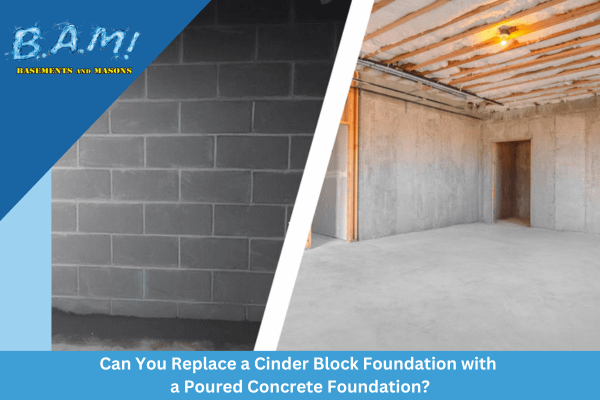Not known Facts About Best Basement Waterproofing
Not known Facts About Best Basement Waterproofing
Blog Article
Facts About Best Basement Waterproofing Uncovered
Table of ContentsThe Greatest Guide To Best Basement Waterproofing3 Easy Facts About Best Basement Waterproofing ShownBest Basement Waterproofing Can Be Fun For EveryoneSome Ideas on Best Basement Waterproofing You Should KnowIndicators on Best Basement Waterproofing You Need To Know
uses excavation techniques towards the base of the framework's foundation. includes getting rid of wetness after it has actually gotten in the basement. AdvantaClean's trained professionals and professionals will find the water source. If wall surface or slab splits are present, we will inject polyurethane and epoxies into the fractures and seal the compromise, stopping further dampness from entering.If there's condensation outside of the foil, you have high humidity in your cellar. Fix it with a mobile area dehumidifier or a whole-house humidifier system rather of waterproofing products. If the foil has condensation on the within surface (alongside the wall surface), the dirt around your home may be naturally damp from a high water table or bad dirt drain.
You can waterproof just your indoor walls, which might fix the trouble. Or you can waterproof your exterior wall surfaces, which is a better wager but more costly. Below's the inside story on the various types: These thick layers are cement-like. Once they dry, they adhere permanently to concrete and stonework wall surfaces (Best Basement Waterproofing).
Our Best Basement Waterproofing PDFs
Swirl the brush at the last of application to offer the wall surface an attractive, finished appearance. Concrete waterproof finishings can't be put on formerly painted surface areas; examine the tag. A 5-gallon container expenses concerning $60. Recognized as densifiers, they are ideal only for walls that haven't been painted or secured.
However you clean, roll, or spray it on much more thickly one gallon covers just 75 square feet, not the 300 square feet common with typical paint. Water-proof paint is fine for do it yourself application. You can apply it over painted surfaces, and paint over it once it's healed (one gallon prices $37).
It can cost $10,000 to $15,000, relying on the work needed. Outside waterproofing entails excavating throughout your house fully depth of the structure wall surfaces, after that mounting a water-proof covering or membrane covered by drainage panels. The panels offer a very easy path for water to stream to an outside French drainpipe at the end of your structure.
A basement without waterproofing is kind of like that. Your cellar does not desire to go through a rainstorm without correct security just as much as you do not desire to.
The Basic Principles Of Best Basement Waterproofing
If you have actually done your research, you would certainly know there are two types of waterproofing: inside and exterior. It can get puzzling what they both mean, which one's a better investment, and what will actually keep the water out. Do not stress, we created this blog site to conveniently define both approaches for you and review the advantages and disadvantages of each.
Outside waterproofing is a waterproofing technique that entails sealing your home from the outside. It's sort of like a moat around a castle. It entails digging a trench around your entire house down to the foundation (regarding 8 to 10 feet down). The structure walls are after that cleaned, secured, and covered with a waterproof membrane layer or sealer.

The Only Guide to Best Basement Waterproofing
It's an extra involved procedure that requires excavating up your backyard, which is expensive and time-consuming. Outside waterproofing involves getting rid of everything surrounding your home, including porches, driveways, pathways, landscaping, air conditioning devices, decks, and more. If any one of the job was done improperly and water is still entering your basement, there isn't much you can do to fix or repair it.
Inside basement waterproofing involves waterproofing from the within. Any kind of water that leakages right into your basement is redirected before it touches your flooring. It's sort of like using a raincoat under your garments. It entails two points: a water drain track and a sump pump. It functions by sealing the within of your cellar walls and floorings so water that tries to get in is funnelled out through a sump pump.
It's a reliable method to water-proof your cellar - Best Basement Waterproofing. The downside of indoor cellar waterproofing primarily has to do with the installation procedure. This approach calls for kept products, furniture, and built-in shelving or cabinets to be relocated from touching the cellar walls. And throughout installment, your cellar can't be made use of. The biggest distinction in between both techniques is this: Exterior waterproofing is a preventative remedy and interior waterproofing visit homepage is a rehabilitative solution.
Best Basement Waterproofing Fundamentals Explained
Finally, exterior and indoor basement waterproofing are both efficient methods of safeguarding your home from water damage. Exterior waterproofing creates a barrier that avoids water from entering your home, while interior waterproofing redirects water that does enter your home. And it's vital to note that outside waterproofing is an expensive and disruptive installation process when contrasted to indoor waterproofing.
Whichever method you select, make sure you pick a trustworthy and credible contractor for the work. If you have any kind of questions concerning cellar waterproofing, please get to out to us.
You can submit our kind below, start a conversation in the lower right-hand corner, or call us at 1-800-827-0702.
Report this page